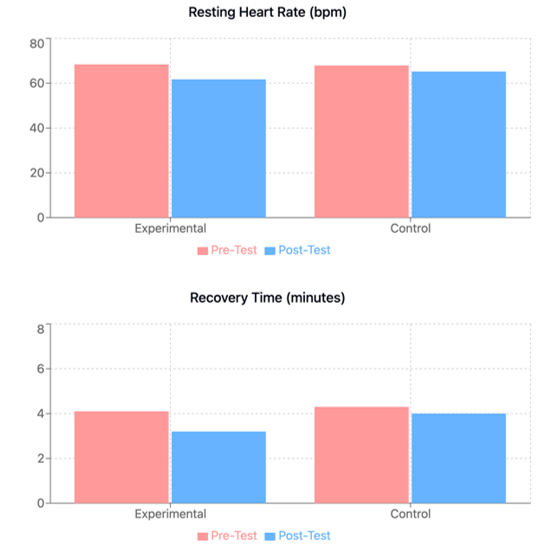The Effectiveness of Interval Training on Endurance Improvement in Adolescent Tennis Players
DOI:
https://doi.org/10.51574/ijrer.v4i1.3416Keywords:
Adolescent Athletes, Cardiovascular Fitness, Endurance, Interval Training, TennisAbstract
Tennis is a sport that requires high endurance capacity, especially for adolescent athletes who are in their physical development phase. Interval training has been recognized as an effective method for improving cardiovascular endurance and sport-specific performance. This study aims to analyze the effectiveness of interval training in improving endurance in adolescent tennis players. This research employed a quasi-experimental design with a pretest-posttest control group approach. The study involved 40 adolescent tennis players aged 14-17 years, divided into two groups: an experimental group (n=20) receiving interval training and a control group (n=20) receiving conventional training. The intervention was conducted for 8 weeks with a training frequency of 3 times per week. Endurance was measured using the multistage fitness test (beep test) and tennis-specific endurance tests. The results showed significant improvement in endurance capacity in the experimental group compared to the control group (p<0.05). The experimental group showed an average increase of 18.5% in VO2max, while the control group only showed 7.2% improvement. Tennis-specific endurance tests also demonstrated superior results in the interval training group. Conclusion: Interval training proves to be more effective than conventional training methods in improving the endurance capacity of adolescent tennis players. This training method can be recommended as an optimal approach for developing cardiovascular fitness in young tennis athletes.
References
Atakan, M. M., Li, Y., Koşar, Ş. N., Turnagöl, H. H., & Yan, X. (2021). Evidence-based effects of high-intensity interval training on exercise capacity and health: A review with historical perspective. International journal of environmental research and public health, 18(13), 7201.
Bank, N., Hecht, C., Karimi, A., El-Abtah, M., Huang, L., & Mistovich, R. J. (2022). Raising the young athlete: training and injury prevention strategies. Journal of the pediatric orthopaedic society of North America, 4(2), 462.
Best, O., & Ban, S. (2021). Adolescence: physical changes and neurological development. British Journal of Nursing, 30(5), 272-275.
Coates, A. M., Joyner, M. J., Little, J. P., Jones, A. M., & Gibala, M. J. (2023). A perspective on high-intensity interval training for performance and health. Sports Medicine, 53(Suppl 1), 85-96.
Deliceoğlu, G., Kabak, B., Çakır, V. O., Ceylan, H. İ., Raul-Ioan, M., Alexe, D. I., & Stefanica, V. (2024). Respiratory muscle strength as a predictor of VO2max and aerobic endurance in competitive athletes. Applied Sciences, 14(19), 8976.
Deng, N., Soh, K. G., Huang, D., Abdullah, B., Luo, S., & Rattanakoses, W. (2022). Effects of plyometric training on skill and physical performance in healthy tennis players: A systematic review and meta-analysis. Frontiers in Physiology, 13, 1024418.
Desbrow, B. (2021). Youth athlete development and nutrition. Sports Medicine, 51(Suppl 1), 3-12.
Doan, S. N. (2021). Allostatic load: Developmental and conceptual considerations in a multi‐system physiological indicator of chronic stress exposure. Developmental psychobiology, 63(5), 825-836.
Duncombe, S. L., Barker, A. R., Bond, B., Earle, R., Varley-Campbell, J., Vlachopoulos, D., ... & Stylianou, M. (2022). School-based high-intensity interval training programs in children and adolescents: A systematic review and meta-analysis. PloS one, 17(5), e0266427.
Engel, F. A., Ackermann, A., Chtourou, H., & Sperlich, B. (2018). High-intensity interval training performed by young athletes: A systematic review and meta-analysis. Frontiers in physiology, 9, 1012.
Guo, Y., Xie, J., Dong, G., & Bao, D. (2024). A comprehensive review of training methods for physical demands in adolescent tennis players: a systematic review. Frontiers in Physiology, 15, 1449149.
Jones, A. M., & Vanhatalo, A. (2017). The ‘critical power’concept: applications to sports performance with a focus on intermittent high-intensity exercise. Sports Medicine, 47, 65-78.
Kaya, E. Ö., & Karahan, M. U. S. T. A. F. A. (2019). Physical performance characteristics of university male tennis players in division I and II. Physical education of students, 23(5), 256-261.
Kolman, N. S., Kramer, T., Elferink-Gemser, M. T., Huijgen, B. C., & Visscher, C. (2019). Technical and tactical skills related to performance levels in tennis: A systematic review. Journal of sports sciences, 37(1), 108-121.
Lee, J., & Zhang, X. L. (2021). Physiological determinants of VO2max and the methods to evaluate it: A critical review. Science & Sports, 36(4), 259-271.
Lubans, D. R., Eather, N., Smith, J. J., Beets, M. W., & Harris, N. K. (2022). Scaling-up adolescent high-intensity interval training programs for population health. Exercise and sport sciences reviews, 50(3), 128-136.
Martarelli, C. S., Berthouzoz, P., Bieleke, M., & Wolff, W. (2023). Bored of sports? Investigating the interactive role of engagement and value as predictors of boredom in athletic training. Sport, Exercise, and Performance Psychology, 12(2), 141.
Morais, J. E., Kilit, B., Arslan, E., Soylu, Y., & Neiva, H. P. (2024). Effects of a 6-week on-court training program on the International Tennis Number (ITN) and a range of physical fitness characteristics in young tennis players. Frontiers in Sports and Active Living, 6, 1304073.
Myer, G. D., Faigenbaum, A. D., Chu, D. A., Falkel, J., Ford, K. R., Best, T. M., & Hewett, T. E. (2011). Integrative training for children and adolescents: techniques and practices for reducing sports-related injuries and enhancing athletic performance. The Physician and sportsmedicine, 39(1), 74-84.
Poon, E. T. C., Wongpipit, W., Sun, F., Tse, A. C. Y., & Sit, C. H. P. (2023). High-intensity interval training in children and adolescents with special educational needs: a systematic review and narrative synthesis. International Journal of Behavioral Nutrition and Physical Activity, 20(1), 13.
Shrom, S. J., Cumming, J., & Fenton, S. J. (2023). Lifestyle challenges and mental health of professional tennis players: an exploratory case study. International Journal of Sport and Exercise Psychology, 21(6), 1070-1090.
Vechin, F. C., Conceição, M. S., Telles, G. D., Libardi, C. A., & Ugrinowitsch, C. (2021). Interference phenomenon with concurrent strength and high-intensity interval training-based aerobic training: an updated model. Sports Medicine, 51(4), 599-605.
Yue, T., Wang, Y., Liu, H., Kong, Z., & Qi, F. (2022). Effects of high-intensity interval vs. moderate-intensity continuous training on cardiac rehabilitation in patients with cardiovascular disease: a systematic review and meta-analysis. Frontiers in Cardiovascular Medicine, 9, 845225.
Zagatto, A. M., Kondric, M., Knechtle, B., Nikolaidis, P. T., & Sperlich, B. (2018). Energetic demand and physical conditioning of table tennis players. A study review. Journal of Sports Sciences, 36(7), 724-731.

Downloads
Published
How to Cite
Issue
Section
License
Copyright (c) 2024 Ilham Azis, Yusnadi Yusnadi, Muhammad Qasash Hasyim

This work is licensed under a Creative Commons Attribution-ShareAlike 4.0 International License.









1.png)













